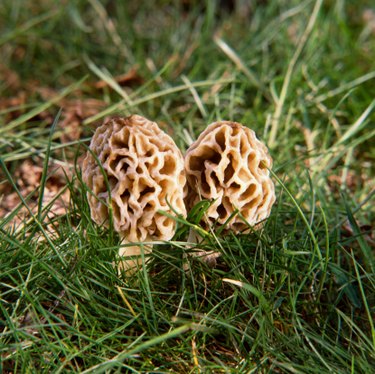
Morels are a favorite quarry of mushroom hunters. The fungi are easy to identify but difficult to find. The mushrooms appear for only a short time each spring, so knowing when and where to look for them is critical. Morel mushrooms are among the safest wild mushrooms to eat. Connoisseurs describe the morel's taste as earthy and nutty, with a meaty flavor.
Where to Search
Video of the Day
Like other mushrooms, the morel is the fruit that emerges above ground from an extensive underground root-like system called mycelium, which grows in concert with tree roots. Fungi consume organic matter, so morels typically sprout up beneath dead or dying trees, especially elm, sycamore, oak, maple, ash and cottonwood. Old orchards are another place to search for morels, especially under cherry trees. Hardwood and deciduous trees are the spots to seek white or yellow morels, while conifer trees provide the right conditions for black or gray morels. In the western U.S., where summer forest fires are common, morels emerge in impressive numbers in some burned areas the following spring in response to the rapid release of nutrients into the soil from fire-killed trees.
Video of the Day
Time of Year
Morels emerge during a three- to four-week period in spring, typically April or May in most of North America. Some mushroom seekers claim the emergence coincides with lilac blooms; others rely on dogwood blooms, and still others say that watching for wildflower blooms in the forest is the best indicator of when to hunt morels.
Weather Conditions
Weather conditions play a vital role in the emergence of morels. The ground needs to be warm, so periods of sunny days when temperatures rise into the 70s set the timetable. A soaking rain just before those warm days or several days of light rain preceding mild weather are perfect conditions. Morels may not always emerge in the same place each year because wind and weather in prior seasons affect the scattering of spores.
Collecting Morels
Snip the morel just above ground level to keep most of the dirt off the mushroom and to avoid damaging the fragile mycelium below. The remaining stem will wither and the mycelium will grow new stems as needed. Collect morels in a mesh bag to provide ample air circulation around the mushrooms and to allow reproductive spores from the caps to drop out as you hunt, increasing the chances of successful hunts in future seasons.
Precautions
Early spring is also a time when snakes, ticks and poison ivy appear. Wear a long-sleeved shirt and long pants, plus sturdy boots. Watch where you reach. Snakes like to curl up among the leaves and grasses where morels grow. Make certain you have positively identified a true morel before cooking and consuming it. False morels look similar but are poisonous; the toxins can build up in the body and cause problem years later.